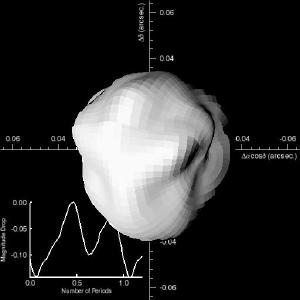Blog
The Shape of Things
29 December 2013
Determining the shapes of smaller asteroids is a bit of a challenge. There are over a thousand asteroids larger than 30 kilometers in diameter, and we simply don’t have the resources to make high resolution images of them. Worse, some of them are small enough that even observations with the Hubble telescope wouldn’t produce a very clear image.
One way we can get an idea of the shape of asteroids is to look at the brightness of an asteroid over time. These are known as light curves, and they can be taken by small-ground based telescopes. In fact, measuring light curves over time is one way amateur astronomers contribute data. Their results can be very high quality, such as this one by Emmanuel Conseil.
Asteroids tend to rotate as they orbit, and as they do, different sides of them face the Sun. The amount of light we see depends on the brightness of the asteroid’s surface (its albedo) and the amount of the surface that is in light and shadow. By looking at the light curve of an asteroid, we can learn not only about its period of rotation, but also about the shape of the asteroid.
 NEAR
NEARBy observing the light curves over time, we get an idea of the illuminated surface over time. We can then use computer models to simulate the effect with different shapes. By tweaking the shape to match the light curve data, we can get an idea of the overall shape of an asteroid, such as in the image below.
When the NEAR spacecraft reached the asteroid Eros in 2000, we were able to put this method to the test. Models of Eros based upon light curve data had already been created, and these were in good agreement with the actual shape of Eros as seen in close images. We can’t use the light curve method to determine high resolution features, but it does give us a good basic idea of the shape.
What’s interesting about this method is how relatively low-tech it is. Light curves are pretty easy to get. A desktop computer has enough power to model asteroid shapes. Not all cutting edge research in astronomy needs the latest equipment.